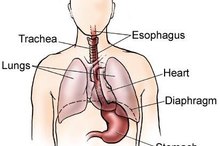Complications After Surgery With the Whipple Procedure
The Whipple procedure, also called a pancreatoduodenectomy, is surgery that treats pancreatic and small bowel cancer. The surgery is named for Dr. Allan Oldfather Whipple, who pioneered the procedure. During the complex operation, surgeons remove the upper section of the small intestine, the gallbladder, the head of the pancreas, a section of the bile duct and sometimes the lower section of the stomach. After the organs' removal, the surgeon reconstructs digestive tract. This risky surgery has several serious complications associated with it and a long recovery time.
If you are experiencing serious medical symptoms, seek emergency treatment immediately.
Fistula and Leakage
A fistula, or abnormal connection, may form between the remaining pancreas and areas in the abdomen. The suture line connecting the pancreas to the small intestine may heal slowly and leak pancreatic juice. The leaking makes internal organs stick together. Surgeons leave drainage tubes in place for a few days after surgery to help drain any juice that may leak. The leaking trickles off. Any fistulas that form may require additional surgery to repair.
- A fistula, or abnormal connection, may form between the remaining pancreas and areas in the abdomen.
- The suture line connecting the pancreas to the small intestine may heal slowly and leak pancreatic juice.
Infection
Causes for Severe Abdominal Pain & Swelling
Learn More
Pancreatitis in the remaining pancreas is a common issue after the procedure. Pancreatitis is an infection or inflammation of the pancreas. The incision may also become infected. Symptoms of an infection after surgery include fever, swelling or redness at the incision site, increased pain and drainage from the surgical incision. Antibiotics help decrease the pain associated with the condition and help clear up the infection.
- Pancreatitis in the remaining pancreas is a common issue after the procedure.
Delayed Stomach Emptying
After surgery, it may take up to a week for the digestive tract to function normally. The physician allows a diet of clear liquids before advancement to a regular diet after surgery. The stomach may be slow to release food at the beginning. This may cause a full feeling after a small portion of food, as well as abdominal bloating. According to the Center for Pancreatic and Biliary Diseases at the University of Southern California, about 25 percent of people undergoing a Whipple procedure have problems with a partial stomach paralysis 1.
- After surgery, it may take up to a week for the digestive tract to function normally.
Diabetes
Complications of Hiatal Hernia Surgery
Learn More
The major role of the pancreas is to produce insulin for the body. Insulin helps break down sugar in the body. Once the head of the pancreas is removed, the remaining pancreas may have problems attempting to produce enough insulin to cover the sugar intake. Some patients develop diabetes for a short time following surgery. The decrease in pancreatic function may also cause fattier stool, evidenced by the stool floating.
- The major role of the pancreas is to produce insulin for the body.
Weight Loss
Weight loss is a concern for patients undergoing the Whipple procedure. According to the Mayo Clinic, the average patient loses about seven percent of her pre-surgery weight.
Related Articles
References
- Center of Pancreatic and Biliary Diseases: Whipple Operation
- University of Chicago Medicine Comprehensive Cancer Center. Whipple Procedure: Frequently Asked Questions.
- Fernandez-del Castillo C. Clinical management of intraductal papillary mucinous neoplasms of the pancreas. The Pancreas Foundation. Updated February, 2017.
- The National Pancreas Foundation. Whipple procedure.
- Oregon Health and Science University. OHSU Knight Cancer Institute. Neuroendocrine cancer.
- Johns Hopkins Medicine. Whipple Procedure.
- Tan-Tam C, Segedi M, Chung S. Whipple procedure: Patient selection and special considerations. Open Access Surgery. 2016;9:51-63 doi:10.2147/OAS.S99636
- Oncolex Oncology Encyclopedia. Whipple procedure.
- Kleeff J, Diener MK, Z'graggen K, et al. Distal pancreatectomy: Risk factors for surgical failure in 302 consecutive cases. Ann Surg. 2007;245(4):573-82. doi: 10.1097/01.sla.0000251438.43135.fb
- Pancreatic Cancer Action Network. Whipple procedure (pancreaticoduodenectomy).
- Paiella S, De pastena M, Pollini T, et al. Pancreaticoduodenectomy in patients ≥ 75 years of age: Are there any differences with other age ranges in oncological and surgical outcomes? Results from a tertiary referral center. World J Gastroenterol. 2017;23(17):3077-3083. doi:10.3748/wjg.v23.i17.3077
- Varshney A, Dhua AK, Jain V, Agarwala S, Bhatnagar V. Whipple's pancreaticoduodenectomy in pediatric patients: An experience from a tertiary care center. J Indian Assoc Pediatr Surg. 2018;23(4):212-215. doi:10.4103/jiaps.JIAPS_35_18
- Muniraj T, Barve P. Laparoscopic staging and surgical treatment of pancreatic cancer. N Am J Med Sci. 2013;5(1):1-9. doi:10.4103/1947-2714.106183
- Johns Hopkins Medicine. What is positron emission tomography (PET)?
- The American Cancer Society. Tests for pancreatic cancer. Updated January 2, 2020.
- Beth Israel Lahey Health Winchester Hospital. Health Library. Whipple procedure.
Writer Bio
Abigail Adams began her freelance writing career in 2009, teaching others about medical conditions and promoting wellness by writing on online health and fitness publications. She is educated and licensed as a registered nurse, having received her degree from North Georgia College and State University.









